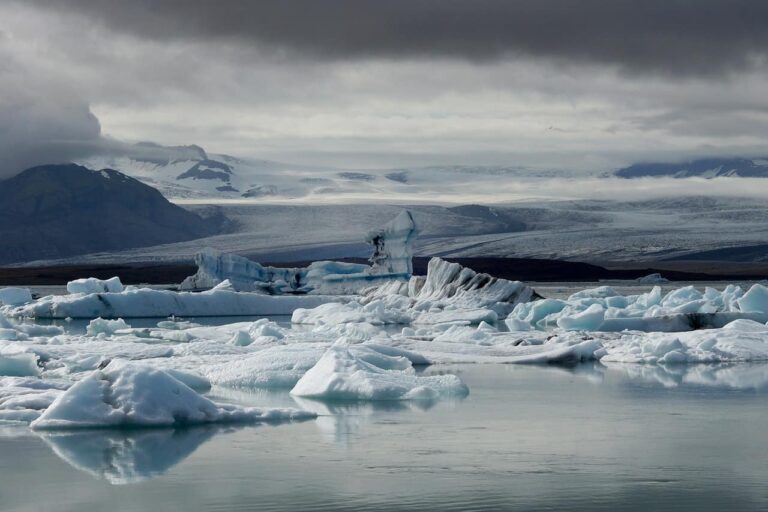Glaciers are large masses of ice that form over long periods from compacted snow in areas where snowfall exceeds snowmelt. These frozen bodies of ice cover around 10% of the Earth’s surface and are found in polar and high-altitude regions.
Melting glaciers refer to the process by which these masses of ice melt and retreat due to various factors such as global warming and human activities. The melting rate of glaciers has increased rapidly in recent years. This has led to concerns about the long-term effects on the environment and society.
This blog will discuss the causes, effects, and solutions to melting glaciers and the importance of addressing this issue.
Table of Contents
The importance of glaciers
The following are some of the most important functions of glaciers:
- Water supply: Glaciers act as natural reservoirs, storing freshwater in the form of ice. When they melt, they provide a steady flow of water to rivers and streams, essential for agriculture, industry, and human consumption;
- Climate regulation: Glaciers help regulate the Earth’s climate by reflecting sunlight into space. As they melt, less sunlight is reflected, leading to increased heat absorption by the Earth’s surface, contributing to global warming;
- Biodiversity: Glaciers provide a unique habitat for various plants and animals adapted to the harsh conditions of the polar and high-altitude regions;
- Tourism: Glaciers are major tourist attractions, attracting millions of visitors each year to locations such as the Alps, Himalayas, and Patagonia. This generates significant revenue for local economies, contributing to the tourism industry.
Causes of melting glaciers
Melting glaciers can be attributed to a combination of natural and human factors. Here are some of the major causes:
- Global warming and climate change: The primary driver is the increase in global temperatures. This increase is caused by the release of greenhouse gases into the atmosphere. As temperatures rise, glaciers are exposed to more heat, leading to increased melting and retreat;
- Human activities: Human activities such as the burning of fossil fuels, deforestation, and industrial processes contribute to the release of greenhouse gases into the atmosphere. This exacerbates global warming and accelerates the melting of glaciers, causing significant environmental impact;
- Natural factors: Although human activities are the primary cause, natural factors such as volcanic eruptions and changes in ocean currents can also contribute to melting. For example, volcanic ash can darken the surface of glaciers, causing them to absorb more sunlight and melt more quickly.
The effects of melting glaciers
The melting of glaciers significantly impacts the natural environment and human societies. Here are some of the major effects:
- Rise in sea level: As glaciers melt, they contribute to the rising sea level. This can severely affect low-lying coastal areas, leading to increased flooding, erosion, and habitat loss;
- Changes in weather patterns: The melting of glaciers can disrupt weather patterns, leading to more extreme weather events such as floods, droughts, and heat waves;
- Impact on ecosystems: The melting of glaciers can significantly impact ecosystems, particularly those in high-altitude and polar regions. Changes in temperature, precipitation, and water availability can affect plant and animal species distribution and survival, leading to biodiversity loss;
- Threat to human settlements and infrastructure: Melting glacier can directly threaten human settlements and infrastructure such as dams, roads, and buildings. As glaciers retreat, they can create unstable terrain and increase the risk of landslides and avalanches.
Read also: Rising sea level, these are the cities that risk to disappear in a few decades
Solutions to melting glaciers
Addressing this problem requires a multi-faceted approach that includes both mitigation and adaptation measures. Here are some of the solutions:
A. Mitigation measures
- Reducing greenhouse gas emissions: The most effective way to mitigate the melting of glaciers is to reduce the amount of greenhouse gases emitted into the atmosphere. This can be achieved through policies and actions aimed at reducing the burning of fossil fuels. E.g., transitioning to cleaner energy sources and implementing carbon pricing mechanisms;
- Energy conservation and transition to renewable sources: Energy conservation and efficiency measures can reduce the demand for energy. While the transition to renewable energy sources such as solar, wind, and hydropower can help reduce greenhouse gas emissions and mitigate the effects of climate change.
B. Adaptation measures
While mitigation measures are crucial to address the root causes of melting glaciers, adaptation measures are also necessary to cope with the effects of climate change that are already underway. Here are some of the adaptation measures:
- Developing early warning systems: Early warning systems can help communities prepare for and respond to the risks posed by a melting glacier, such as flooding and landslides. These systems can alert residents, emergency responders, and local authorities, enabling them to take appropriate action to protect lives and property;
- Building protective infrastructure: Infrastructure such as seawalls, levees, and drainage systems can help protect coastal communities and other vulnerable areas from flooding and erosion. This protection is necessary due to rising sea levels and melting glaciers caused by climate change. In addition, green infrastructure such as wetlands and forests can provide natural protection against these risks.
We need to protect glaciers from melting and preserve them for future generations
The melting of glaciers is a complex issue requiring mitigation and adaptation measures. Reducing greenhouse gas emissions is the most effective way to mitigate the melting of glaciers. Adaptation measures such as early warning systems and protective infrastructure are also necessary to cope with the already underway climate change effects.
The impact of melting glaciers is far-reaching and can have severe consequences for the natural environment and human societies. We must take action now to address the issue of melting glaciers. This can be done through policies and actions aimed at reducing greenhouse gas emissions, promoting sustainable development practices, and building resilience to the impacts of climate change.
Read also: Antarctica, alarming new record as ice is at 45-year low: a brief anomaly or a long-term transition?












